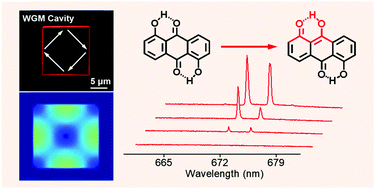Organic single-crystalline whispering-gallery mode microlasers with efficient optical gain activated via excited state intramolecular proton transfer luminogens†
Abstract
A suitable energy level system of organic laser gain material is vital for the realization of organic solid-state lasers (OSSLs). In this work, it is experimentally demonstrated that the excited state intramolecular proton transfer (ESIPT) occurred within ∼1.4 ps in the singlet excited state (S1*) of the organic dye 1,5-dihydroxyanthraquinone (1,5-DHAQ). An optimized energy level system is thereby constructed via the ESIPT process for efficient optical gain, and a deep red laser emission at ∼672 nm with a low threshold of 0.39 μJ is achieved based on the self-assembled square microdisks of 1,5-DHAQ, which simultaneously function as the high quality (Q ∼ 2033) whispering-gallery mode (WGM) cavity and efficient laser gain medium. Our work realizes the efficient WGM OSSL with a favored energy level system based on the ESIPT process, providing insight into the ESIPT lasing mechanism. The results would ultimately contribute to the development of organic coherent light sources.



 Please wait while we load your content...
Please wait while we load your content...